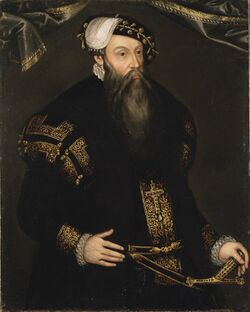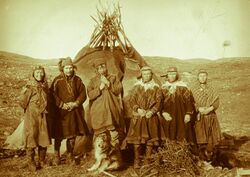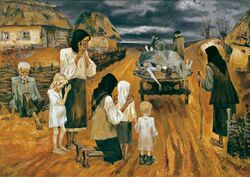Valkea
This article is incomplete because it is pending further input from participants, or it is a work-in-progress by one author. Please comment on this article's talk page to share your input, comments and questions. Note: To contribute to this article, you may need to seek help from the author(s) of this page. |
Republic of Valkea Valken Tasavalta | |
|---|---|
Motto: "Ikuisesti Valkea!" (Valkean) Forever Valkea! (English) | |
| Capital and largest city | Våren Livet |
| Official languages | Valkean |
| Demonym(s) | Valkean |
| Government | Semi-presidential parliamentary republic |
| Afanasi Koski | |
| Iris Sirkka | |
| Legislature | Parliament |
| Population | |
• 2020 estimate | 44,318,267 |
• 2015 census | 42,679,351 |
| GDP (nominal) | estimate |
• Total | $2.47 trillion |
• Per capita | $57,401 |
| Gini (2015) | low |
| HDI (2015) | 0.917 very high |
| Currency | Krona (Kr) |
| Date format | dd-mm-yyyy |
| Driving side | right |
| Calling code | +91 |
| Internet TLD | .vk |
The Republic of Valkea (Valkean: Valken Tasavalta), more commonly known as Valkea, is a sovereign country in Northern Lorecia, in the region of Astyria. It is bordered by the Aurora Confederacy to the southwest, the Western Tundra to the south, Caledonia to the east, and Nynorsk Ostlijord to the northeast. It shares a maritime boundary with Romberg to the northwest. Valkea has a population of over 44 million people, and over 70% of the population living in the southernmost third of the country. Its capital and largest city is Våren Livet.
Valkea was inhabited soon after the end of the last Ice Age at approximately 8500 BC. Pottery was introduced in 5000 BC, followed by agriculture in 2000 BC. The Bronze and Iron Ages were characterized by contact with other cultures in Northern Lorecia as well as the slow introduction of sedentary communities. Between 1400 BC and 1200 BC, proto-Valki peoples migrated from what is now Western Tundra and Caledonia, creating three distinct cultures: Valki, Velgi, and Lumimaa.
Beginning from the 9th century, the Vikings arrived in northern Valkea and began exploring the coasts, establishing small kingdoms and duchies in the area. These quickly unified into the Kingdom of Valkea, which continued for more than a millennium. After being torn by civil war in the early 20th century, Valkea was declared a republic in 1923. It established a policy of neutrality since the 1940s, though it has made many close partnerships with countries from different blocs.
Valkea was a relative latecomer to industrialization, remaining largely agrarian until the 1930s. The country rapidly developed an advanced economy while also building an extensive welfare state, which has resulted in widespread prosperity and one of the highest per capita incomes in Astyria. It has been a top performer in many metrics such as education, economic competitiveness, civil liberties, quality of life, human development, and standard of living.
Etymology
The name Valkea has uncertain origins, but a possible source could be attributed to the Old Valkean word valke, meaning "white", used to describe the appearance of the region during winter. Originally the name referred to the southernmost regions of the country, with other regions such as Maarinnat sometimes excluded until later. Another similar source could be from the name valkemaa—the earliest known mention of this word can be found in a travel document dating from the 14th century.
History
Prehistory
The first settlements in Valkea date back to 8500 BC, shortly after the last Ice Age. The earliest people were hunter-gatherers that used stone tools. Archeological findings throughout Valkea discovered artifacts the settlers left behind that share characteristics with other artifacts found in other parts of Northern Lorecia.
Pottery first appeared in 5000 BC, while agriculture was introduced between 3000 and 2500 BC in southern Valkea. Permanant year-round cultivation and animal husbandry came about in 2000 BC, however hunting and fishing remained the main subsistence goods in early cultures.
Between 1400 and 1200 BC, waves of people migrated from what is now the Western Tundra and Caledonia. These people brought the first bronze artifacts to the region, as well as the proto-Valkean languages. Domestic production of bronze began in 1000 BC, while iron was introduced in 500 BC.
In the 1st century AD, the Iron Age population began to grow, and contact with other cultures around Northern Lorecia became more frequent. The Valkean region exported furs and timber to cultures in Central Lorecia, while it imported fabrics, jewelry, and glass.
Vikalki Era
From the 9th century to the 11 century AD, Viking peoples arrived in Astyria, raiding, pillaging, and settling all over Lorecia and Northern Teudallum. Some of these Vikings started settling the coastal and riverine areas of northwest Lorecia, founding settlements such as Dagsmark, Osterlund, Korsholm, Helgeboda, and Sorvisto.
The native inhabitants of Valkea referred to these new peoples as "Vikalki". These independent Vikalki settlements grew thanks to extensive trade between each other and with other cities throughout Northern Lorecia, as well as from raids conducted elsewhere, which made them rich and powerful. They intermingled with the Valki over several decades, eventually forming the basis of the modern Valkean ethnicity.
It is not know how exactly Valkea was unified, but Valkean tradition states that Haakon the Stout united the Vikalki chieftains at the Battle of Nolvik, becoming the first king of a united Valkea in 1016. The sagas further add that Haakon was a just and fair ruler who ruled with a strong hand. However, Valkea was still a loosely united kingdom, and struggled to maintain its territorial integrity—particularly against raiding groups originating from Tundra that plundered southern Valkea in the first half of the 12th century.
Beginning in the 11th century AD, Christianity was introduced to Valkea, especially through the efforts of St. Arne. However, the new religion did not fully displace paganism as the majority religion until the 12th century. From 1134 onwards, Valkea was counted as a Christian kingdom.
Kingdom of Valkea
Beginning in the 13th century, the Valkean kings strived to expand their domain northward to the Opsala region. This led them into contact with the Koivunen Confederation, a loose alliance of central and northern Valki tribes that refused to submit to Valkean sovereignty. A series of wars followed from 1216 to 1246, which resulted in the annexation of their territories by Olof II.
At the same time, numerous crusades were conducted against the northern Valki and the Lumikki to convert them to Christianity, and colonization efforts of the Pikkimaa coast were initiated. This effort intensified in the 14th century, and the western and northern coasts were predominantly inhabited by Valkeans.
Due to their relative isolation from the rest of Lorecia, feudalism never developed in Valkea as it did elsewhere. Most of the peasantry were largely freemen, and serfdom was quite uncommon. Slavery existed in tiny pockets of Valkea, which were slowly driven out of existence thanks to the spread of Christianity. Eventually it was banned altogether by a decree of Knut the Tall in 1318. In spite of this, Valkea remained an economically backward country compared to the rest of Lorecia, and much of their economy relied on trade with the outside world.
Mannerheim Dynasty
The death of Knut the Tall in 1338 caused a brief succession crisis, and Dalmar of Mannerheim ascended to the throne. Dalmar, unlike his predecessors, was a Valki that rose through the ranks and attained the rank of Duke in 1332. His claim lay with his marriage to Tove, eldest daughter of Knut. Dalmar was crowned king by the Archbishop of Kiesimä in 1342, reigning from Mannerheim Castle. This would be the de facto capital of Valkea for 105 years until the royal family moved to the nearby settlement of Våren Livet in 1447.
In the 1400s and 1500s, Valkea launched another wave of colonization and expansion, adding Lumimaa and parts of the Velgi region to its territory. Following this territorial expansion was a second round of Crusades aimed at the pagan populations. Beginning in 1465, these Crusades extended to Nynorsk, which soured relations between the two formerly related states. The Nynorsk War raged from 1481 to 1496, resulting in a Nynorsk victory.

The Protestant Reformation arrived in Valkea in 1526, and Pekka I declared his rejection of Catholicism. He also proceeded to disband the position of the Archbishop of Kiesimä, as well as nationalized the church's assets, which created tensions between the remaining Catholics and the growing Protestant communities. A growing religious crisis threatened to tear Valkea apart. In 1553, at the behest of his council, Pekka I's son and successor, Pekka II, convened a Synod in Våren Livet, which formally established the Church of Valkea. From then on, Valkea was regarded as a Protestant and Lutheran state.
Hostilities were renewed between Valkea and Nynorsk Ostlijord over the territory of the Velgi region, which both countries sought to control. As such, many border wars were fought between Valkean and Nynorsk forces and militias from 1592 to 1627, most of which were inconclusive.
In 1635, Wilhelm II died in his sleep, beginning the War of Valkean Sucession. Rivals were quick to fill the power vacuum left by the king's death, claiming succession to the childless Wilhelm. Two major pretenders arose during this time: Tatu, Duke of Westerlund, and Jari-Pekka, Duke of Korsholm. The civil war lasted for twelve years until Jari-Pekka was assassinated by two of his household guards, paving the way for Tatu to become king in 1647.
Westerlund Dynasty
Tatu's first years of his reign were devoted to repelling Nynorsk invaders, who had taken advantage of the weakness of Valkea, which was still reeling from the civil war, to make territorial gains in the north. The Valkean nobles, previously divided in the succession crisis, were united against a common enemy, and the Valkeans defeated the Nynorsk in a decisive victory in the Battle of Rudanmaa.
Valkea's victory over the Nynorsk cemented the northerly kingdom as a great power in Lorecia. Before this, Valkea was an impoverished and backwards country at the edge of Lorecian civilization. However, it rose to prominence under Tatu, who was honored posthumously as Tatu the Great. After the Northern War concluded in 1657, Tatu made sweeping reforms in the Valkean economy, encouraged trade with other nations, and proliferated Protestantism throughout the kingdom.
The remaining portion of the 17th century saw Valkea fight numerous wars against its neighbors, particularly against the Western Tundra from 1662 to 1664, Caledonia from 1674 to 1679, and Rávdnár tribes from the Empire of Exponent from 1700 to 1706. Valkea reached its territorial zenith under Gustaf III in 1723, having wrested large amounts of territory from Caledonia in the Treaty of Osterlund. However, a third war with Caledonia from 1750 to 1761 left the Valkean state's coffers drained and the economy deteriorated. This was further compunded by a famine that swept through Valkea in 1757, which allowed the Caledonians to regain all the land that they lost in 1723, as well as annex certain Valkean border provinces. Valkea was forced to sign a humiliating treaty in 1761, recognizing Caledonia's gains, and as such, Valkea lost its primacy in Northern Lorecia.
In 1795, Marleena, the last monarch of the Westerlund Dynasty, died of stomach cancer. This paved the way for the Vallis Dynasty, which was a cadet house of the Westerlunds, to rise to power. Pekka VI was thus crowned king of Valkea that same year.
Vallis Dynasty
Between 1800 and 1850, the population of Valkea doubled, and trade once again flourished. However, Valkea remained a poor nation, remaining a largely agrarian state even as the rest of Lorecia made begun to industrialize. Despite this, Valkea was able to make enormous changes in the agrarian economy through the introduction of more modern farming techniques, aggressive exploitation of agricultural lands, and new crops such as potatoes.
Throughout the 19th and 20th centuries, the Valkean government embarked on a policy of forced assimilation of the indigenous people of northern Valkea. Many indigenous groups such as the Velgi and Lumimaa were forced to attend Valkean schools, learn the Valkean language, and adhere to Valkean customs and traditions. In addition, thousands of Velgi women underwent forced sterilization, and Valkeans were encouraged to settle in the north through economic incentives from the government. This policy intensified at the turn of the 20th century and continued until 1977.
Eager to reclaim the lands that Valkea ceded to Caledonia in the 3rd Eastern War, Otto II declared war on Caledonia in 1861. The border between the two went back and forth until a compromise was reached at Tuuvalo in 1867. The Treaty of Tuuvalo demarcated the official border between Valkea and Caledonia that still remains to this day.
Modern Era
Valkean Civil War
Valkea was officially neutral in the Great Astyrian War, although it did provide tacit support to both sides of the conflict. Resentment against the monarchy mounted when bad harvests resulted in 1912 and 1916. These two events sent the Valkean economy into freefall, and there were growing calls for revolution. Uprisings in Dagsmark, Vuornaa, and Novika were crushed by government forces in 1918, commencing the Valkean Civil War.
The war lasted for four years and involved three main factions: the Royalists, who supported the status quo and sided with the Valkean monarchy, the Constitutionalists, who called for greatly restricting the monarch's powers and placing power solely in the hands of Parliament, and the Republicans, which called for the abolition of the monarchy altogether in favor of a republic. The Republican faction was initially the smallest out of the three, only controlling portions of the Valkean coast at the start of the war, but they quickly gained territory, taking over much of northern Valkea in 1920. The last of the royalist forces were defeated at the Battle of Harjattula in 1922, allowing the republicans to take the victory.
After the war, a transitional government was established to restore peace and order. The monarchy was abolished and a republic was established. A provisional constitution was drafted to facilitate the change, but it would soon be hijacked by fringe elements.
Kansallist Era
The transitional government of Valkea was quickly taken over by the National Movement, a powerful and influential faction that espoused syndicalism and fascism. In August 1924, the movement ratified a new constitution and holding elections later that year. On 25 January 1925, King Gustaf VI and his family were executed in front of crowds at Pohjola Square. The Nationalists reorganized as the National People's Party (Kansallinen Kansanpoulue) and won most of the seats in the Valkean Parliament in the 1925 election. Markku Vuotola was elected as the nation's first president, while Kaarlo Hietanen was elected as Prime Minister.
Under Vuotola's administration, the Kansallists began to transform Valkea's predominantly agrarian society into an industrialized one. The state began creating various companies in manufacturing, service, and trade, built infrastructure across the country, modernized its military, and established a robust welfare system. The new jobs attracted thousands of people to the cities. Valkeans were also encouraged to start their own businesses to further supplement manufacturing output, especially in rural areas.
While the standard of living was rising among Valkeans, centralized planning led to millions of people dying of starvation—particularly during the Famine of 1930. The Kansallists were also known to suppress freedom of the press and limit freedom of speech. Furthermore, forced assimilation policies against the Velgi intensified, with more intensified Valkean settlement, more widespread forced sterilization, and a scorched earth policy that left thousands of Velgi without food.
The Kansallists maintained Valkea's policy of neutrality during the 2nd Great Astyrian War. This allowed the Valkean government able to forge stronger relationships with countries from various military and economic blocs. The establishment of freer and greater trade with the outside world caused Valkea to develop rapidly, successfully completing the nation's transition to an industrialized economy. In 1950, 52% of Valkean workers were employed in the agricultural sector and a quarter of the population lived in urban areas. By 1975, the number of agricultural workers dropped to 28%. Over the years new jobs in manufacturing, services, and trade drew more people to these urban areas.
However, failed macroeconomic decisions and global economic turmoil led to the Valkean Recession of 1971. The unemployment rate reached an all-time high of 23.2% the following year. Even though the Kansallists reversed the economic crisis by 1974, civil unrest grew significantly in Valkea's major cities, culminating in the Grand March of January 1975. Frustrated Valkeans demanded that the Kansallist Party relinquish its monopoly on power and the decentralization of the economy. The government reluctantly held a snap election in October that same year, and the Democratic Centrist Party won majority seats. The new president, Paavo Itkonen, took his inauguration the following year.
Democratic Era
Under Itkonen's administration, the Valkean government began enacting sweeping reforms over the remainder of the 1970s, as well as the early 1980s. The economy was decentralized in 1977 and many state enterprises were privatized in 1982. There were also many economic regulations that were loosened and modest tax cuts enacted. In the 1980s and 1990s, the economy began seeing record growth for the first time since the 1971 Recession, fueled by the success of private companies such as car manufacturers Sidus and Sorsa, among others, along with rising electronic giants such as Valkea Electric and Architect. Architect at one point held a unique position representing 60% of market capitalization on the Våren Livet Stock Exchange.
Geography and Climate
Valkea is located on the northwestern coast of Lorecia, surrounded by water to the north and west and sharing land borders with Aurora Confederacy to the southwest, the Western Tundra to the south, Caledonia to the east, and Nynorsk Ostlijord to the northeast. It is one of the northernmost countries in Astyria.
The landscape is mostly covered by taiga forests and ferns, with little land deemed suitable for cultivation. The forests consist mainly of pine, spruce, birch, and other related species. The southernmost regions of the country are suitable for farming, while the remainder is suitable for animal husbandry.
Much of Valkea shares a subpolar or boreal climate, but its coastal areas and the entirety of the lowland south are described to be maritime or continental. Because of its northerly location, it experiences long winters and short summers each year. The warm stream originating from the southwest serves to moderate the extreme temperatures.
Government and Politics
Valkea is a unitary semi-presidential republic with a representative democracy. The head of state is the President, currently Afanasi Koski, while the head of government is the Prime Minister, currently Iris Sirkka.
Legislative power is vested in the Eduskunta, a unicameral legislature with 250 members. It may amend the constitution and ordinary laws, dismiss the executive cabinet, and override presidential vetoes.
Political Divisions
Foreign Relations
Military
The Valkean Armed Forces is comprised of the army, navy, and air force, all of which are under the command of the Ministry of Defence. The border guard and coast guard is under the command of the Ministry of the Interior but can be placed under the Ministry of Defence in times of war. The president serves as commander-in-chief of the armed forces.
The country's military doctrine relies on a highly mobile field army backed up by local defense units. Its military strategy employs the use of the country's mountainous terrain and forested geography to wear down any invading force, instead of attempting to hold the attacking army on the frontier.
Its peacetime strength numbers at approximately 203,600 personnel in uniform (520,000 in wartime). Valkea employs universal male conscription, under which all male Valkean citizens above 18 years of age serve for 12 to 24 months of armed service or 24 months of non-combatant service. However, both men and women can choose to voluntarily serve in the military.
Crime and Law Enforcement
Economy
The economy of Valkea is one of the most vibrant in Astyria, having a per capita output comparable to other developed Astyrian economies. Its gross domestic product (GDP) in 2015 was $1.13 trillion ($1.21 trillion in PPP). Its key economic sector is manufacturing, with the largest industries being electronics (24.7%), machinery, automobiles, and other metal-based products (22.1%), forestry (12%), and chemicals (11%). However, the largest sector of the economy is the services sector, amounting to 61.7% of GDP, with manufacturing at 36.1%.
Valkea is highly integrated within the Astyrian economy—international trade currently produces 35% of GDP. Its largest trading partners include the Aurora Confederacy, Nynorsk Ostlijord, the Conite Republic, the Blackhelm Confederacy, Ionicus, ViZion, and Nikolia.
The country is blessed with mineral and aquatic resources, as well as timber. Forests play a key role in Valkea's economy, making it one of Astyria's largest wood producers. The government has long played a role in the forestry industry, regulating tree cutting, sponsoring technical improvements, and ensuring that the country's forests continue to provide raw materials for wood-processing industries.
The private sector currently employs about 14 million Valkeans, and nearly half of employees have attained tertiary education. 55% of the workforce is currently employed by small enterprise and accounted for 42% of economic output. Females outnumber males in the workplace, consisting of 57% of all employees working in Valkea. In 2014, the largest private sector employers in Valkea include Architect, VTK, Sidus, Valkean Railway Group, AVS Financial, and Sorsa.
The unemployment rate was 7.5% in 2015, having declined from 8.3% in 2014. Economists note that this recent data is an anomaly in a trend of rising unemployment. However, youth unemployment rose from 15.7% in 2006 to 20.2% in 2016. Nearly one million people throughout the country currently live on minimal wages or wages not enough to cover their costs of living.
Transport
The main land arteries of Valkea consist of extensive road and rail networks, mostly utilized by cargo and passenger traffic. These networks cost about $1.8 billion to maintain, which are wholly paid by vehicle and fuel taxes.
The main international passenger gateway is Vuotola Airport, with about 25 million passengers in 2015. The Vuotola Airport-based Valkea Airlines, Air Klemetti, and Sky High sell flights domestically and internationally.
Most international cargo arrives in Valkea by sea. Laaksonen Port in Våren Livet is the largest container port in the country with a capacity of 31.4 million metric tons.
Demographics
The population of Valkea is currently about 44 million inhabitants as of 2017. Valkea's population has always been concentrated in the southernmost regions of the country, a phenomenon that became more pronounced with urbanization. 7 out of 10 of Valkea's largest cities are located in the south (3 of which can be found in the Våren Livet metropolitan area).
Valkean is the official language of Valkea. Valkean is predominant across most of the country, although a small minority of people near the Nynorsk border speak Norse. 91% of the population speak Valkean as their primary language.
Education
The Valkean education system is considered by many surveys to be one of the best in Astyria. Primary and secondary education is arranged at the municipal level. Most students in Valkea are enrolled in public schools—the remaining 5% are enrolled in private schools (mostly specialist language and international schools). Pre-school education is rare and formal education is usually started at the age of 7. Primary school lasts for six years and lower secondary school three years.
Education is compulsory between the ages of 7 and 16. After lower secondary school, graduates may either enter the workforce directly or continue to pursue further education by applying to a trade school or gymnasium (upper secondary school). Trade schools offer a vocational education while gymnasiums are more oriented towards the academics. Graduation from either formally qualifies for tertiary education.
Culture
Arts and Architecture
Cuisine
Music
Religion
Sports





